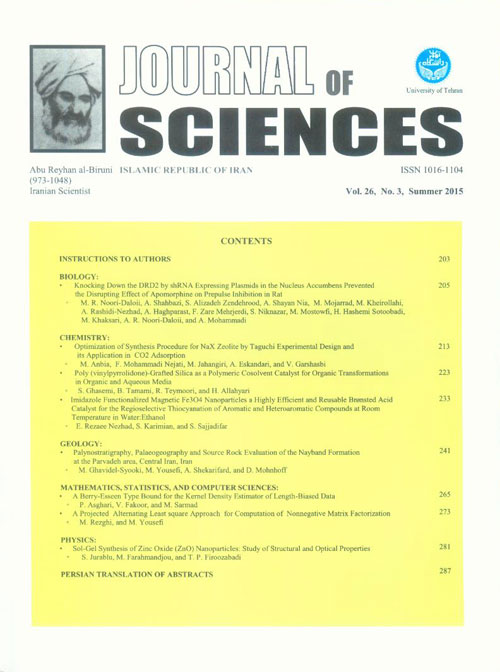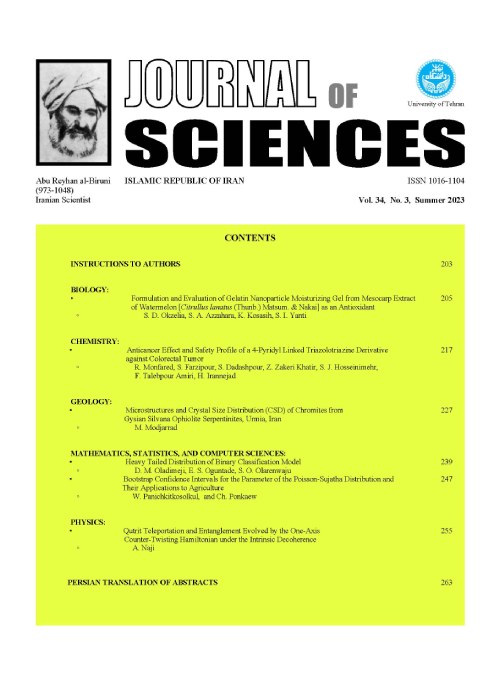فهرست مطالب

Journal of Sciences, Islamic Republic of Iran
Volume:26 Issue: 3, Summer 2015
- تاریخ انتشار: 1394/07/09
- تعداد عناوین: 8
-
-
Pages 205-212Prepulse Inhibition (PPI), the objective measure of sensorimotor gating disturbance has being widely used in animal models of schizophrenia. Dopaminergic direct and indirect agonists impair PPI. However, the profile of dopaminergic receptors involved in PPI impairment by dopamine agonists is not clear. By injecting shRNA expressing plasmids against dopamine D2 receptor genes (DRD2) in the nucleus accumbens, here, we studied the effect of apomorphine on PPI in D2 down-regulated rats. Seventy two adult Wistar rats assigned randomly in nine groups, each received coding (250 and 500 ng/µl) or noncoding shRNA expressing plasmids against DRD2 in the nucleus accumbens, with or without apomorphine (0.5 mg/kg, S.C., 72 hours after treatment with plasmids). Auditory startle response and PPI were measured after apomorphine injection. Real time RT-PCR was used to measure DRD2 expression. Results showed that apomorphine significantly decreased PPI in noncoding plasmid treated rats; While, PPI did not impaired in rats pretreated with 250 and 500 ng/µl shRNA expressing plasmids. Accordingly, the expression of DRD2 mRNA in the nucleus accumbens showed 72-78% decrease in expressing plasmid treated rats. Additionally, treatment with expressing plasmids had no effect on basal PPI and/or auditory startle response. Taken together, our results demonstrated that DRD2 silencing in the nucleus accumbens can prevent PPI impairment by apomorphine. These observations suggest application of molecular techniques such as the use of shRNA against DRD2s in studies of schizophrenia pathophysiology and development of new treatments in schizophrenia.Keywords: shRNA, DRD2, Nucleus Accumbens, Schizophrenia, Prepulse Inhibition
-
Pages 213-222A series of experiments were designed to utilize the Taguchi method for investigating the effects of important parameters on the synthesis of NaX zeolite and to find the best conditions of synthesis. An L9 orthogonal design of Taguchi approach was applied to design experiments consisting of 9 trails. The effect of molar composition, including SiO2/Al2O3 and Na2O/Al2O3 ratios, and the crystallization conditions, including temperature (T) and time (t) on crystallinity and also phase purity of NaX zeolite were investigated. The results revealed that the temperature of crystallization and alkalinity (Na2O/Al2O3) of initial mixture were the most influencing parameters for desirable synthesis of NaX zeolite. To examine the validation the result of Taguchi experiment design, the most crystalline sample was resynthesized and characterized by XRD, SEM and N2 adsorption-desorption methods. At the end, the capability of the obtained sample for CO2 adsorption was determined by the static volumetric method.Keywords: CO2 adsorption, NaX zeolite, Taguchi experimental design, Volumetric gas adsorption, Zeolite synthesis
-
Pages 223-231Poly (vinylpyrrolidone)-grafted silica as an organic-inorganic hybrid material was used as an effective heterogeneous polymeric cosolvent catalyst in organic reactions. This modified silica catalyzed nucleophilic displacement of alkyl halides for easy preparation of alkyl thiocyanates, alkyl cyanides, alkyl azides and alkyl aryl ethers. Furthermore, the catalyst was applied for the conversion of epoxides to thiranes, thiocyanohydrins and azidohydrins. These reactions were performed in acetonitrile and aqueous media to produce the corresponding products in high yields and short reaction times. The catalyst can be recovered and reused several times.Keywords: Polymeric cosolvent, Poly (vinylpyrrolidone), Nucleophilic substitution reactions, Ring opeing of epoxides
-
Pages 233-240The Magnetically recoverable Fe3O4 nanoparticle and the supported brønsted acidic ionic liquid 1-methyl-3-(3-trimethoxysilylpropyl) imidazolium hydrogen sulfate (Fe3O4-IL-HSO4) were synthesized and used as efficient magnetic catalysts for the regioselective thiocyanation of aromatic and heteroaromatic compounds at room temperature in Water: Ethanol. This procedure provided the target thiocyanates after short reaction times in good to excellent yields and high regioselectivity.The catalyst can be readily isolated by using an external magnet and no obvious loss of activity was observed when the catalyst was reused in seven consecutive runs. The mean size and the surface morphology of the nanoparticles were characterized by TEM, SEM, VSM, XRD and FTIR techniques.Keywords: Magnetic nanoparticles, Ionic liquid, Thiocyanation, Regioselective, Room temperature
-
Pages 241-263The Nayband Formation was measured and sampled in Parvadeh area, southern Tabas city. In this area, this formation has a thickness of 1410 m, dividing into four members, namely Gelkan, Bidestan, Howz-e-sheikh and Howz-e-khan. A total 573 samples were treated for Palynological analysis, and only 120 samples were productive. A total of 57 miospore taxa and 11 plant macrofossil were encountered. Based on stratigraphic distribution of macrofossil and miospore taxa ten assemblage zones were established throughout the Nayband Formation. The encountered miospore taxa and plant macrofossil suggest Upper Triassic (Norian-Rhaetian) for the Nayband Formation.Rock-Eval data shows the presence of organic matter-rich shales with Type III kerogen. The Nayband Formation in the studied section has experienced high temperature which is confirmed by vitrinite reflectance measurements of 0.9-1.2 %VRr. At this thermal maturity stage, organic-rich shales in the formation have generated liquid hydrocarbons as evidenced by the occurrence of solid bitumen in the respective samples.Keywords: Palynostratigraphy, Palaegeography, Source Rock, Upper Triassic, Nayband Formation
-
Pages 265-272Length-biased data are widely seen in applications. They are mostly applicable in epidemiological studies or survival analysis in medical researches. Here we aim to propose a Berry-Esseen type bound for the kernel density estimator of this kind of data.The rate of normal convergence in the proposed Berry-Esseen type theorem is shown to be O(n^(-1/6)) modulo logarithmic term as n tends to infinity by a proper choice of the bandwidth.The results of a simulation study is also presented in this paper inorder to examine the performance of the result.Keywords: Asymptotic normality, Berry, Esseen theorem, Kernel estimator, Rate of convergence, Length, biased
-
Pages 273-279Nonnegative matrix factorization (NMF) is a common method in data mining that have been used in different applications as a dimension reduction, classification or clustering method. Methods in alternating least square (ALS) approach usually used to solve this non-convex minimization problem. At each step of ALS algorithms two convex least square problems should be solved, which causes high computational cost. In this paper, based on the properties of norms and orthogonal transformations we propose a framework to project NMF’s convex sub-problems to smaller problems. This projection reduces the time of finding NMF factors. Also every method on ALS class can be used with our proposed framework.Keywords: Nonnegative matrix factorization, Alternating least squares, Initialization, Orthogonal transformation
-
Pages 281-285Zinc oxide (ZnO) nanopowders were synthesized by the sol–gel method from an ethanol solution of zinc sulfate heptahydrate in the presence of diethylene glycol surfactant. Detailed structural and microstructural investigations were carried out using x-ray diffraction (XRD), high-resolution transmission electron microscopy (HRTEM), field emission scanning electron microscopy (FE-SEM), Fourier transform infrared spectroscopy (FTIR) and UV-Vis spectrophotometer. XRD pattern showed that the zinc oxide nanoparticles exhibited hexagonal wurtzite structure. The average particle size of ZnO was achieved around 28 nm as estimated by XRD technique and direct HRTEM observation. The surface morphological studies from SEM and TEM depicted spherical particles with formation of clusters. The sharp peaks in FTIR spectrum determined the purity of ZnO nanoparticles and absorbance peak of UV-Vis spectrum showed the wide bandgap energy of 3.49 ev.Keywords: ZnO nanoparticles, Sol, gel method, Crystal structure, Optical properties


